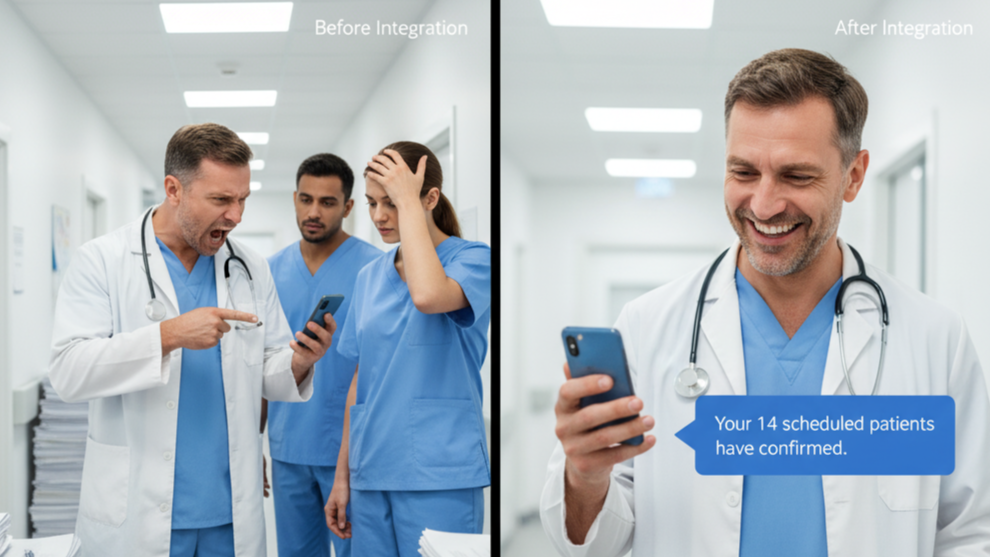Which Part of Your Workflow Needs Integration First?
💡Not every process needs integration on day one. The key is knowing where to begin. By identifying the most painful parts of your...
7 min read
Gregory Vic Dela Cruz : 8/29/25 10:00 AM
.png)
Every clinic relies on an electronic medical record (EMR) system to store schedules, patient data, and visit notes. But the EMR alone doesn’t solve the communication gaps that result in no-shows, missed follow-ups, and overloaded phone lines. That’s where a solution tailored specifically for medical practices comes in. It integrates your EMR with a patient communication platform that automates reminders, enables two-way texting, and streamlines intake.
The concept is simple. Let the EMR remain the source of truth, while a communication layer turns its data into actionable workflows. These are three quick wins you can expect:
From reminders and intake forms to text-to-pay and post-visit surveys, integration makes each step of the patient journey smoother. This blog covers the essentials of integration—what EMR connection means, why it matters, and how clinics can implement it without ripping and replacing their existing system.
Every clinic feels the strain of disconnected systems, whether they realize it or not. On the surface, the EMR looks like it handles everything—it stores patient charts, manages schedules, and tracks encounters. But the EMR alone is rarely enough to manage the communication and workflow demands of a modern clinic. Without a plaftform tying it to patient communication platforms, inefficiencies pile up and patients slip through the cracks.
Here’s how the problems unfold.
In clinics without integration, staff spend hours dialing patients, leaving voicemails, and documenting confirmations by hand. Even after all that work, no-show rates remain stubbornly high. Why? Because reminders aren’t always timely, accurate, or easy for patients to act on. If a patient confirms by phone but the EMR isn’t updated instantly, staff may continue calling unnecessarily. If a reminder is sent for the wrong time or location because systems don’t sync, patients show up unprepared or not at all. These manual processes create more labor without solving the attendance problem.
Paper intake or standalone e-forms require staff to re-enter data into the EMR. With hundreds of entries per week, errors are inevitable. Misspelled names, incorrect insurance IDs, and incomplete histories lead to billing denials and clinical risks. Providers grow frustrated when patients are asked to repeat information that should already be in the chart. Administrators see denial rates climb, A/R days increase, and patient trust erode as inefficiencies become obvious.
Patients today expect clarity and consistency. But in many of their healthcare experiences, they often receive mixed messages. A robocall reminder might say one thing, a voicemail another, and a printed instruction sheet yet another. When schedules change, the updates don’t ripple across systems, so one patient may get told the wrong prep instructions while another shows up at the wrong site. Confusion damages trust, and once trust erodes, patients disengage and look for more reliable providers.
Disconnected workflows also slow down revenue. Clinics relying on mailed statements or manual collection calls are fighting an uphill battle. Patients forget, lose paperwork, or simply don’t prioritize payment. Staff spend hours chasing balances, often unsuccessfully. Accounts receivable piles up, cash flow suffers, and administrators face pressure from leadership to explain missed financial targets. Without integration that ties text-to-pay directly into reminders and follow-ups, collections remain slow and unpredictable.
All of these issues compound on the front line. Staff are trapped in reactive cycles—chasing patients, fixing errors, and re-entering data—rather than delivering service. The phones never stop ringing. The inbox overflows with voicemails. Check-in lines grow as staff juggle paper forms and EMR screens. This inefficiency is draining, leading to low morale and high turnover. Burnout becomes a real risk when the daily experience is constant firefighting.
Ultimately, the cost isn’t just operational—it’s experiential. Patients left waiting on hold, repeating paperwork, or receiving mixed instructions walk away frustrated. They may not leave a review, but they quietly switch providers or spread negative word of mouth. In an era where convenience drives loyalty, disjointed workflows are a liability.
Without EMR integration, clinics run on effort instead of efficiency. Staff are overburdened, patients are underserved, and revenue is underperforming. The fix isn’t more staff or more hours—it’s integration that turns EMR data into automated, accurate, and actionable communication.
When clinics implement EMR integration, the difference is immediate and measurable. Integration ties the EMR—the system of record—to a patient communication platform that automates reminders, enables two-way texting, digitizes intake, and accelerates collections. Instead of working harder, staff finally work smarter. Here’s how integration changes the game across the patient journey.
When you integrate your EMR, reminders pull directly from the EMR’s live schedule. That means patients always receive the right time, date, provider, and location—even when changes are made last minute. Clinics can set cadences by visit type—72 hours, 24 hours, 2 hours before a procedure, for example. Patients confirm with a tap, and updates sync back instantly. The result: fewer no-shows, fewer last-minute gaps, and more predictable provider utilization. For administrators, it translates to stabilized revenue and reduced overtime spent chasing confirmations.
Instead of staff tied up on phones, patients text their questions and requests. A shared, HIPAA-compliant inbox makes it easy for multiple staff members to respond, with templates for common needs like directions, prep instructions, or insurance uploads. Appointment context from the EMR is visible in every thread, so staff respond accurately in seconds. Clinics consistently report a 40–50 percent drop in call volume after adoption. Staff reclaim hours each week, patients get faster answers, and everyone benefits from smoother communication.
Clipboards disappear when forms are sent automatically after booking. Patients complete demographics, health histories, and consents from their phone. They upload IDs and insurance cards securely, and all data flows directly into the EMR. Staff simply validate instead of retyping, cutting check-in times in half. Errors drop, denials fall, and providers start visits with complete, legible information. Patients appreciate the convenience, especially when they can handle forms at home instead of in the waiting room.
Billing becomes part of the same communication flow patients already use. Co-pays can be requested in advance with a link sent alongside reminders. Balances are sent after visits, with secure links patients can pay from their phone. Administrators track which messages were delivered, opened, and paid, making follow-up precise. This reduces days in A/R, strengthens cash flow, and lowers the burden on staff to chase unpaid accounts. Clinics report increases of 30–40 percent in collection speed after implementing text-to-pay.
Integration doesn’t stop at billing. After visits, automated surveys go out, asking patients to rate their experience. Positive scores trigger review requests, boosting the clinic’s online reputation. Negative scores route to staff for service recovery, ensuring issues are addressed before they become public complaints. One clinic using this model gained over 100 new five-star reviews in three months—without staff effort. Reputation becomes systematic, not accidental, driving more patient acquisition long-term.
Because everything is connected, administrators can finally measure performance. Dashboards track confirmation times, no-show rates, average check-in durations, collection percentages, and survey response rates. These metrics allow leaders to spot bottlenecks and refine workflows continuously. Instead of guessing at ROI, administrators show hard numbers to providers and boards, strengthening the case for further investment.
.png?width=959&height=367&name=connect-emr-to-communication-system-mid%20(1).png)
These aren’t outliers—they’re typical outcomes when EMR integration is implemented thoughtfully.
For staff, integration means calmer days, fewer interruptions, and more control over workloads. Burnout risk falls as repetitive, manual tasks disappear. For patients, it means accurate reminders, clear prep instructions, faster check-ins, and easy payments. Both sides feel the difference almost immediately, building momentum and trust in the new system.
Ultimately, EMR integration transforms communication from a burden into a strategic advantage. By automating the small but critical steps of scheduling, intake, messaging, billing, and feedback, clinics create a cycle of efficiency and satisfaction that compounds over time. The EMR remains the system of record, but with integration, it becomes the engine of a modern, patient-friendly clinic.
Curogram provides a HIPAA-compliant communication platform that integrates with almost any EMR. The goal is to connect systems so staff can stop duplicating work and start focusing on patients. Here’s how Curogram works.
Curogram works with virtually all major EMRs. Data flows one way from the EMR into Curogram, powering reminders, forms, and communication without disrupting existing workflows. Implementation is fast, and staff can learn the system in under 10 minutes.
Practices using Curogram consistently report fewer no-shows, fewer calls, smoother intake, faster payments, and stronger online reputations. Staff describe it as a lifesaver that reduces stress and increases productivity. Patients of all ages appreciate the convenience of texting and digital forms.
With Curogram, effortless EMR integration becomes a reality—not a project that drags on for months. Clinics see measurable improvements in weeks.
Disconnected systems cost time, money, and patient trust. By connecting your EMR to a patient communication platform, you automate the workflows that matter most: reminders, messaging, intake, billing, and surveys. The result is fewer no-shows, calmer staff, happier patients, and stronger revenue.
Curogram makes integration simple, fast, and effective. With HIPAA-compliant features designed for real clinic workflows, it delivers immediate results and long-term growth. Your EMR remains the system of record, while Curogram turns its data into action.
Ready to see integration in action? Book your free demo today and learn how you can give your patients and staff the experience they deserve.
.png)
💡Not every process needs integration on day one. The key is knowing where to begin. By identifying the most painful parts of your...

💡Clinic workflow integration changes everything. Before integration, staff juggle phone calls, paperwork, and disconnected systems. After...

💡EMR integration reduces no-shows by making reminders automatic, accurate, and actionable. Disconnected systems leave gaps in communication,...